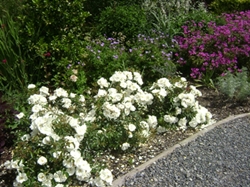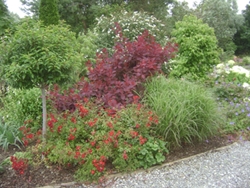
PINK FLOWER CARPET ROSE controlling the traffic at Trim.
Flower carpet roses own some of their success to good marketing. In Ireland they are field grown by Hughes Roses, potted and sold on by Rentes Plants to their usual high standard. The patent is held in Europe. At the same time, if they were not good garden plants, their success would be short lived. I remember how good a seller Houttuynia “Chameleon” was. It looked so well in a pot with its striking multicoloured foliage. Unfortunately in the garden it was a different matter, running everywhere, except where you wanted it.
Pink flower carpet was the first introduction, and the most successful. Its colour, which to me is a little strong, shows up well against the foliage, particularly from a distance. It has been used with great success in public plantings, such as the roundabouts at Trim town. Its other name could be the “roundabout rose”!
White Flower Carpet Rose mixing effortlessly with hardy geraniums.

White flower carpet has clear white flowers, good against the darker foliage. (White flowered plants often have pale leaves) It mixes well with other plants, and great in these informal modern planting styles. One of its drawbacks is the relatively large size and the fullness of its flowers which result in a lot of unsightly spent petals. This is often a problem with white flowers and particularly bad in this years weather. Hitting the bushes with a bamboo cane is a good lazy mans way of dislodging them.
Red Velvet Carpet Rose in front of the suberb Cotinus ‘Grace’.

Flower carpet red velvet is a little disappointing, the colour is dull and the flowers single and flat. The darkish foliage doesn’t help things and the growth habit is lax. There is a better red variety out now called scarlet . Having said that, my planting of red velvet is actually looking good this season and standing up very well to the weather, one of the advantages of flowers with fewer petals.
Finally flower carpet amber has the most gorgeous vibrant colour, but a little difficult to place with other colours, particularly dark reds and mauves. It looks stunning with blue.
Rose Kent still looking tidy despite the rain.

Another group of patented roses are the county series, named after English counties, so a lot of them end in ‘shire’. I grow Wiltshire, which is similar to flower carpet pink, but no blue in the flower, giving it a softer hue. Kent is white and very similar in habit to flower carpet white, except the flowers – not the plants – are smaller and tighter. I prefer it to flower carpet white. A little pink comes into the flowers as they fade.
Magic Carpet is a nice ground cover rose, with pink flowers which age to a light purple, giving the entire bush a gentle two tone effect. I had it for years but could never identify it, until a few weeks ago when Brian Hughes from Hughes roses called in, and told me its name. A great rose he said, but a poor seller – which is often the case with good garden plants.
Roses have suffered a decline in popularity from their heyday in the middle of the last century. Formal rose beds are not in fashion, and roses are used more sparingly amongst other garden plants. The more informal habit of such roses as the flower carpets, fit better into the modern garden. But another reason, probably more important, is the general public’s aversion to spraying, and many of the older varieties needed lots. In most situations carpet roses can get away with no spraying. There is sometimes a little leaf spotting, but only noticeable close up.
Roses in pots in peat based composts are really disease prone, much more so than in the open ground. Black spot and in particular downy mildew is a huge problem with potted roses. To me it looks like blackspot, and it can defoliate the plants very quickly, making them unsaleable. We’ve put our rose sales benches under cover so we get none of the above diseases, but a little bit of powdery (real) mildew instead – nature always catches you out some way. It’s much easier to deal with though, once it’s spotted early.
Roundup and Roses.
Roses are very susceptible to Roundup (glyphosphate) damage nearly all year round, as they are rarely dormant. And there is usually soft growth close to the ground, which takes in the weedkiller readily. (God be with the days when we had CASARON G, which was great for controlling weeds around roses and so easy to use. But alas, it’s gone perhaps forever, and will become a distant memory, like SIMAZINE before it.)
Effectively, roses should be treated as though they were soft herbaceous plants, when it comes to using Roundup. Roses will recover from light Roundup damage, which can be helped by pinching out or removing effected shoots. Damage can show up for a number of seasons.
Source: HortiTrends News Room




